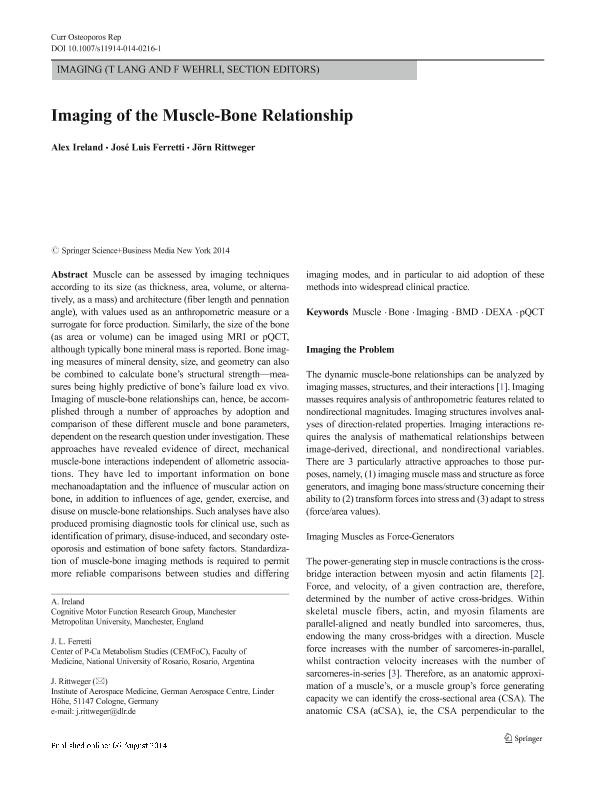Artículo
Imaging of the muscle-bone relationship
Fecha de publicación:
12/2014
Editorial:
Springer
Revista:
Current Osteoporosis Reports
ISSN:
1544-2241
Idioma:
Inglés
Tipo de recurso:
Artículo publicado
Clasificación temática:
Resumen
Muscle can be assessed by imaging techniques according to its size (as thickness, area, volume, or alternatively, as a mass) and architecture (fiber length and pennation angle), with values used as an anthropometric measure or a surrogate for force production. Similarly, the size of the bone (as area or volume) can be imaged using MRI or pQCT, although typically bone mineral mass is reported. Bone imaging measures of mineral density, size, and geometry can also be combined to calculate bone’s structural strength—measures being highly predictive of bone’s failure load ex vivo. Imaging of muscle-bone relationships can, hence, be accomplished through a number of approaches by adoption and comparison of these different muscle and bone parameters, dependent on the research question under investigation. These approaches have revealed evidence of direct, mechanical muscle-bone interactions independent of allometric associations. They have led to important information on bone mechanoadaptation and the influence of muscular action on bone, in addition to influences of age, gender, exercise, and disuse on muscle-bone relationships. Such analyses have also produced promising diagnostic tools for clinical use, such as identification of primary, disuse-induced, and secondary osteoporosis and estimation of bone safety factors. Standardization of muscle-bone imaging methods is required to permit more reliable comparisons between studies and differing imaging modes, and in particular to aid adoption of these methods into widespread clinical practice.
Archivos asociados
Licencia
Identificadores
Colecciones
Articulos(CCT - ROSARIO)
Articulos de CTRO.CIENTIFICO TECNOL.CONICET - ROSARIO
Articulos de CTRO.CIENTIFICO TECNOL.CONICET - ROSARIO
Citación
Ireland, Alex; Ferretti, Jose Luis; Rittweger, J; Imaging of the muscle-bone relationship; Springer; Current Osteoporosis Reports; 12; 4; 12-2014; 486-495
Compartir
Altmétricas




